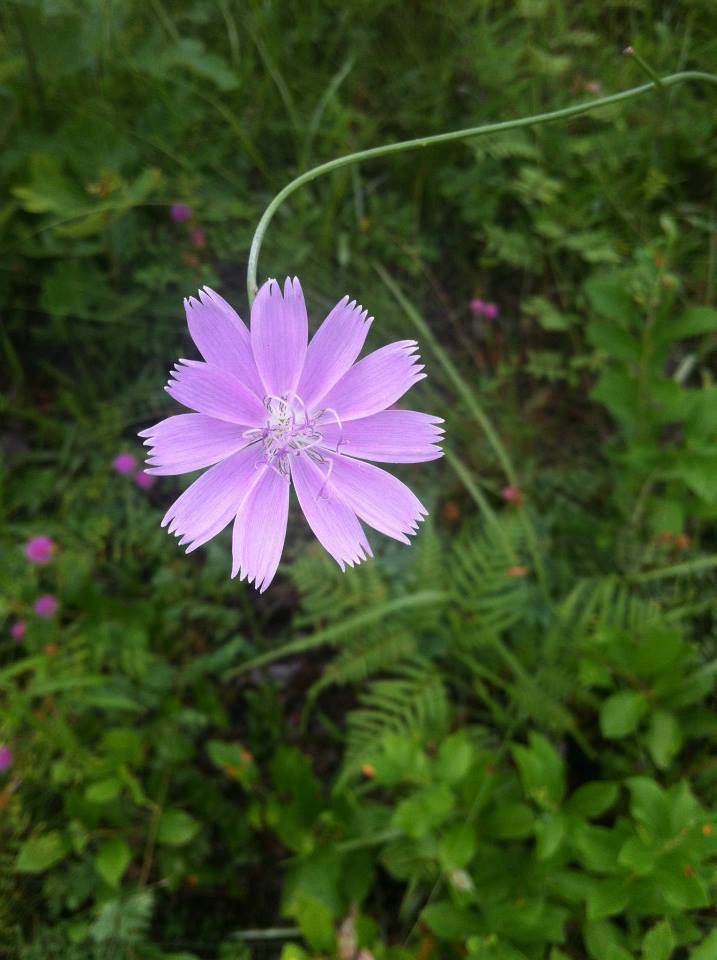Lygodesmia aphylla
| Lygodesmia aphylla | |
|---|---|

| |
| Photo taken by Michelle M. Smith | |
| Scientific classification | |
| Kingdom: | Plantae |
| Division: | Magnoliophyta - Flowering plants |
| Class: | Magnoliopsida – Dicotyledons |
| Order: | Asterales |
| Family: | Asteraceae ⁄ Compositae |
| Genus: | Lygodesmia |
| Species: | L. aphylla |
| Binomial name | |
| Lygodesmia aphylla (Nutt.) DC. | |

| |
| Natural range of Lygodesmia aphylla from USDA NRCS Plants Database. | |
Common name: rose-rush, flowering straw, Florida skeletonplant[1]
Contents
Taxonomic notes
Synonyms: none[1]
Varieties: none[1]
Description
A description of Lygodesmia aphylla is provided in The Flora of North America.
The root system of Lygodesmia aphylla includes corms which store non-structural carbohydrates (NSC) important for both resprouting following fire and persisting during long periods of fire exclusion.[2]. Diaz-Toribio and Putz (2021) recorded this species to have an NSC concentration of 26.8 mg/g (ranking 89 out of 100 species studied).[2]
According to Diaz-Torbio and Putz (2021), Lygodesmia aphylla has corms with a below-ground to above-ground biomass ratio of 0.21 and nonstructural carbohydrate concentration of 26.78 mg g-1.[3]
Distribution
L. aphylla ranges from central Georgia to southern Florida and west to central Panhandle Florida.[1]
Ecology
Habitat
It is found in Florida scrub community (Archbold Biological Station).[4] This species has also been found in sandhills, pine flatwoods, pine-wiregrass savannas, and mixed woodlands.[5] It has been observed in open areas in dry, deep, moist-peaty, and loose sands as well as in gravelly soils.[5] This species also occurs in human disturbed areas such as clobbered scrub oak habitats, bulldozed areas, orange groves, along roadsides, along old fields, cut-over pinelands, fallow fields, spoil banks, and parks.[5] Associated species include Rosemary, scrub oaks, Pinus clausa, P. elliottii var. densa, Quercus laevis, Aristida stricta, Andropogon, Pinus elliottii, Tragia urens, and Rubus cuneifolius.[5]
Lygodesmia aphylla is an indicator species for the Central Florida Flatwoods/Prairies community type as described in Carr et al. (2010).[6]
Phenology
L. aphylla has been observed flowering in April to June with peak inflorescence in May.[5][7]
Seed dispersal
This species is thought to be dispersed by wind.[8]
Fire ecology
Populations of Lygodesmia aphylla have been known to persist through repeated annual burns.[9][5][10]
Pollination
Lygodesmia aphylla has been observed at the Archbold Biological Station to host sweat bees such as Augochlorella aurata (family Halictidae).[11] Deyrup observed the sweat bee Augochlorella aurata (family Halictidae) on L. aphylla.[4]
Herbivory and toxicology
Fire ants are not interested in the seeds of L. aphylla.[12]
Conservation, cultivation, and restoration
Cultural use
Photo Gallery
References and notes
- ↑ 1.0 1.1 1.2 1.3 Weakley, A.S. 2020. Flora of the Southeastern United States. Edition of 20 October 2020. University of North Carolina at Chapel Hill, Chapel Hill, North Carolina.
- ↑ 2.0 2.1 Diaz-Toribio, M.H. and F. E. Putz 2021. Underground carbohydrate stores and storage organs in fire-maintained longleaf pine savannas in Florida, USA. American Journal of Botany 108: 432-442.
- ↑ Diaz‐Toribio, M. H. and F. E. Putz. 2021. Underground carbohydrate stores and storage organs in fire‐maintained longleaf pine savannas in Florida, USA. American Journal of Botany 108(3):432-442.
- ↑ 4.0 4.1 Deyrup, M. J. E., and Beth Norden (2002). "The diversity and floral hosts of bees at the Archbold Biological Station, Florida (Hymenoptera: Apoidea)." Insecta mundi 16(1-3).
- ↑ 5.0 5.1 5.2 5.3 5.4 5.5 Florida State University Robert K. Godfrey Herbarium database. URL: http://herbarium.bio.fsu.edu. Last accessed: June 2014. Collectors: Loran C. Anderson, Robert F. Thorne, Gary R. Knight, Mark A Garland, R.K. Godfrey, Grady W. Reinert, S. W. Leonard, Robert J Lemaire, Gwynn W. Ramsey, R. S. Mitchell, O. Lakela, George R. Cooley, Carroll E. Wood, Jr., Kenneth A. Wilson, H. Larry Stripling, H. E. Grelen, Robert Kral, Mabel Kral, Mary Clare Langan, Elmer C. Prichard, Paul L. Redfearn, Jr., C. Jackson, Patricia Elliot, R. Komarek, M. Davis, J. M. Kane, Leon Neel, Julie Neel, R. A. Norris, and Cecil R Slaughter. States and Counties: Florida: Calhoun, Charlotte, Citrus, Clay, Duval, Franklin, Gulf, Hernando, Highlands, Indian River, Jackson, Lee, Leon, Levy, Liberty, Marion, Pasco, Pinellas, Polk, Sarasota, Suwannee, Volusia and Wakulla. Georgia: Baker and Thomas.
- ↑ Carr, S.C., K.M. Robertson, and R.K. Peet. 2010. A vegetation classification of fire-dependent pinelands of Florida. Castanea 75:153-189.
- ↑ Nelson, G. PanFlora: Plant data for the eastern United States with emphasis on the Southeastern Coastal Plains, Florida, and the Florida Panhandle. www.gilnelson.com/PanFlora/ Accessed: 12 DEC 2016
- ↑ Kirkman, L. Katherine. Unpublished database of seed dispersal mode of plants found in Coastal Plain longleaf pine-grasslands of the Jones Ecological Research Center, Georgia.
- ↑ Robertson, K.M. Unpublished data collected from Pebble Hill Fire Plots, Pebble Hill Plantation, Thomasville, Georgia.
- ↑ Platt, W.J., R. Carter, G. Nelson, W. Baker, S. Hermann, J. Kane, L. Anderson, M. Smith, K. Robertson. 2021. Unpublished species list of Wade Tract old-growth longleaf pine savanna, Thomasville, Georgia.
- ↑ Deyrup, M.A. and N.D. 2015. Database of observations of Hymenoptera visitations to flowers of plants on Archbold Biological Station, Florida, USA.
- ↑ Cumberland, M. S. and L. K. Kirkman (2013). "The effects of the red imported fire ant on seed fate in the longleaf pine ecosystem." Plant Ecology 214: 717-724.